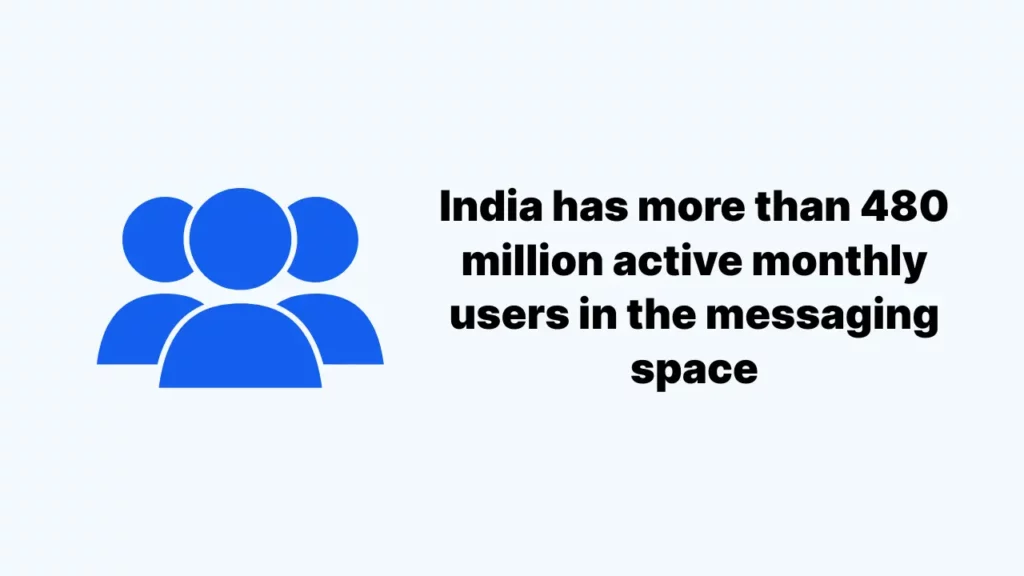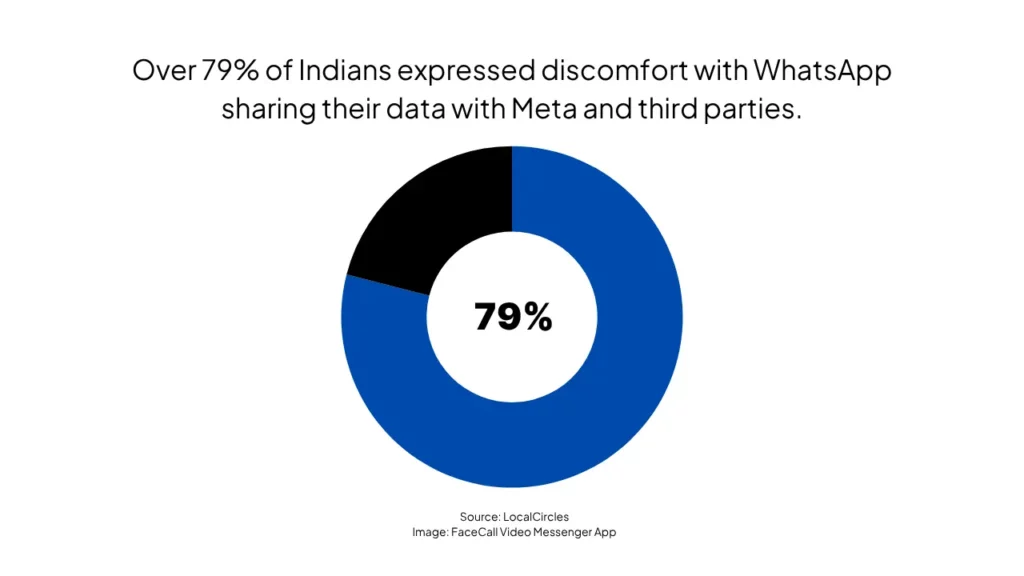India has become one of the largest communication markets, with no particular one-app preference.
India has more than 480 million active users in the messaging space. Some consumers prefer WhatsApp, while others use Signal, and some use FaceTime.

However, with a growing understanding of communication apps, concerns about data privacy, spam overload, and feature bloat have also emerged, opening the door to serious alternatives.
While apps like Telegram and WhatsApp have already created and carved a strong niche with creators and educators, FaceCall is quickly emerging as one of the most preferred video calling apps for Indian users.
This guide compares Telegram, WhatsApp, and FaceCall, not from a marketing lens, but based on how real people in India currently use these apps.
A Quick Snapshot
| Feature | Telegram | FaceCall | |
| Monthly Active Users (India) | 480M+ | 120M+ | Growing Fast |
| Ownership | Meta | Telegram FZ LLC | Independent |
| End-to-End Encryption (Default) | Yes | No (optional) | Yes |
| Spam Control | Weak | Moderate | Strong (With Video Caller ID) |
| Built for Indian Languages | Partial | No | Full Support |
| Call Quality on Low Networks | Average | Variable | High (Optimized for 3G) |
| Monetization | Meta Ads | Freemium/Donations | None (No ads) |
User Experience and Interface
WhatsApp initially kept its interface simple, but clutter quickly crept in. There are tabs for Communities, Channels, Status, Payments, and AI integrations, which have started to confuse older and less tech-savvy users.
Telegram takes a different route. It’s sleek, customizable, and designed for people who want more control, with custom folders, theme options, and chatbot access all built in. But that flexibility comes at the cost of usability. First-time users often find it overwhelming.
FaceCall stands in stark contrast by going back to the basics, but doing it better than both WhatsApp and Telegram. The interface is lightweight and distraction-free, with purposeful additions like regional language toggles, video caller ID, and a smart call filter that blocks unknown spam calls before the phone even rings.
Verdict:
- For simplicity: WhatsApp (if you can ignore the extras)
- For customization: Telegram
- For clean, practical design: FaceCall
Privacy: WhatsApp vs Telegram vs FaceCall
After WhatsApp’s 2021 privacy policy debacle, the conversation around user data changed forever. According to a survey by LocalCircles (2023), over 79% of Indians expressed discomfort with WhatsApp sharing their data with Meta and third parties.

WhatsApp encrypts messages, but metadata = like who you chat with, when, and for how long, is still logged and shared across Meta platforms.
Telegram, by default, doesn’t encrypt one-on-one messages unless you open a “Secret Chat.” Group messages are never end-to-end encrypted. Telegram also stores messages on its cloud infrastructure, which—while convenient—introduces security trade-offs.
FaceCall is built on a privacy-first architecture and is one of the best secure Telegram alternatives for iOS. No Meta pixels, no ad libraries, and no cross-platform tracking. End-to-end encryption is always on, and because the app doesn’t rely on cloud storage for messages, user behavior stays on the device, making it one of the best Telegram and WhatsApp alternatives in India.
Verdict:
- For real privacy: FaceCall
- For partial control: Telegram
- For minimal control: WhatsApp
Group Chats and Broadcasts: WhatsApp vs Telegram vs FaceCall
India has become a hotbed for group-based communication. Whether it’s coaching classes, school groups, or residential colonies, messaging groups are how communities move.
WhatsApp allows up to 1,024 participants in a group, with basic admin controls. But spammers often abuse the broadcast feature, especially for marketing.
Telegram is in a league of its own here:
- Groups: Up to 200,000 members
- Broadcast Channels: Unlimited subscribers
- Admin Bots: Automation for moderation and engagement
This makes it the platform of choice for creators, public figures, and businesses that want scale and reach.
FaceCall, while not aiming to replicate Telegram’s massive numbers, focuses on quality group conversations. Group calls can be scheduled, recordings are optionally available, and the video caller ID ensures you know who’s trying to join. It’s not built for mass reach, but for meaningful communication.
Verdict:
- For scale: Telegram
- For personal group control: FaceCall
- For average group use: WhatsApp
Calling and Voice Features: WhatsApp vs Telegram vs FaceCall
WhatsApp’s calling experience is stable, but far from flawless. In areas with weak signal, especially Tier 2 and 3 cities, voice and video calls often drop or lag.
Telegram introduced voice and video calling much later, and its performance varies significantly across regions. It works well with strong networks but has known issues with jitter and latency on patchy mobile data.
FaceCall outperforms both in this category. The app is optimized for low-bandwidth conditions and uses adaptive bitrate streaming to maintain clarity even on 3G. Call scheduling, smart reminders, and built-in call recording (with consent toggles) take the experience a step further.
Verdict:
- For bandwidth-constrained calls: FaceCall
- For stable urban calls: WhatsApp
- For limited calling use: Telegram
Regional Language Support: WhatsApp vs Telegram vs FaceCall
India is not a monolingual market. According to KPMG India (2022), 68% of digital users prefer content in regional languages, and that includes messaging apps.
WhatsApp supports 10+ Indian languages but still struggles with full interface translation and text prediction consistency in languages like Tamil, Gujarati, and Assamese.
Telegram is mostly English-first. While you can change interface text, there’s limited effort toward deep regional customization or predictive inputs for Indic languages.
FaceCall was built for India, and it shows. From onboarding to call logs to voice commands, the app supports over 15 Indian languages natively, including options for automatic language switching based on device settings.
Verdict:
- For language inclusivity: FaceCall
- For partial support: WhatsApp
- For English-only environments: Telegram
File Sharing, Media Compression, and Storage
File sharing is a key part of messaging now, especially for students, professionals, and business teams across India.
WhatsApp imposes a 2GB limit for file transfers. While media compression has improved slightly, it still compresses images and videos heavily unless manually sent as a document. This often jeopardizes the image or video quality, which is also a dealbreaker for users who want to share clear PDF documents or crisp videos.
Telegram is the clear leader in this category. It allows files up to 2GB per file and doesn’t compress media unless you want it to. Telegram also supports persistent cloud storage, which means your files are available on any device, even years later.
FaceCall, instead of trying to match Telegram’s cloud repository, focuses on practical file sharing. Files can be shared directly during a call or message thread. More importantly, media is not auto-compressed, and you have full control over how it’s saved, backed up, or auto-deleted. That’s helpful for users on limited storage phones who want manual control.
Verdict:
- For large, uncompressed files: Telegram
- For practical file sharing with manual control: FaceCall
- For casual use with limits: WhatsApp
Multi-Device and Desktop Experience
With people increasingly using multiple devices, the ability to continue conversations seamlessly across them has become important.
WhatsApp introduced multi-device support in 2023, but it still has limitations. You can’t use two phones with the same number easily, and certain features don’t sync well (like starred messages, view-once media, or media history).
Telegram, on the other hand, nails multi-device support. You can log into unlimited devices, and everything syncs instantly. This makes it ideal for creators, admins, and users who need to bounce between laptops and mobiles often.
FaceCall supports one account, multiple device login, but doesn’t have a web app that mirrors your chats on desktop yet. Its focus is more on maintaining a clean, minimal interface rather than offering advanced desktop features like Telegram. But for users who prefer using one app across phone and PC, FaceCall will soon introduce the desktop client too.
Verdict:
- For full multi-device use: Telegram
- For basic sync across devices: FaceCall
- For single-device focus: WhatsApp
App Size and System Performance
App bloat is a real concern in India. Millions of users still operate on entry-level Android devices with limited RAM and storage. Heavy apps often lag, crash, or eat battery.
WhatsApp is reasonably optimized but has grown in size and memory consumption due to added features like Channels, Payments, and Status. On low-end phones, performance dips noticeably during heavy usage.
Telegram is heavier still, especially with its persistent storage and caching. While power users may not mind, basic users often report lag and background battery drain.
FaceCall is built to run clean on low-RAM devices. It maintains a small APK footprint, avoids heavy background sync, and skips bloated SDKs that slow performance. Even on older phones with 2GB of RAM, it offers smooth navigation, instant call loading, and minimal overheating. If you want an effective Telegram alternative for Android, FaceCall is what you should be trying.
Verdict:
- For speed on older phones: FaceCall
- For modern phones: Telegram
- For mid-range usage: WhatsApp
(Use Case)WhatsApp vs Telegram vs FaceCall: Which App Fits You Best
Here’s a final breakdown by user type. This should help you decide based on your actual needs, not just features.
| User Type | Best App | Why |
| Rural Users with Weak Networks | FaceCall | Clean calling experience on 3G, regional language support |
| Privacy-Focused Professionals | FaceCall or Telegram | Full encryption and zero ad model (FaceCall), advanced control (Telegram) |
| Digital Creators / Community Leaders | Telegram | Massive groups, bots, and broadcast tools |
| Government / Business Teams | FaceCall | Secure communication and role-based controls |
| Elderly or Less Tech-Savvy Users | FaceCall | Simple interface, no clutter, caller ID protection |
| People Who “Just Want WhatsApp” | Familiarity, family usage, status updates |
Final Thoughts: Why FaceCall Deserves Your Attention
This isn’t a pitch. It’s the reality of where messaging in India is headed.
WhatsApp still dominates in numbers. But its focus is no longer on the user. It’s on integration with the Meta ecosystem, extracting value from your activity across platforms, and turning messaging into a commerce hub.
Telegram is versatile and powerful, but often too complex for casual users. Its lack of default encryption and increasing move toward monetization makes it less ideal for users seeking trust by default.
FaceCall is built differently. It’s not trying to be the next WhatsApp or Telegram. It’s trying to be better where it actually matters:
- Calls that connect even when nothing else does
- Video caller IDs that help you avoid spam
- Full regional support so you don’t have to compromise on language
- No ads, no tracking, no bloated distractions
If you’re done with the noise and ready for messaging that feels like it was actually built for you, then FaceCall is the most serious WhatsApp alternative in India today.
And you can try the app for free by downloading it for both Android and iOS devices.

